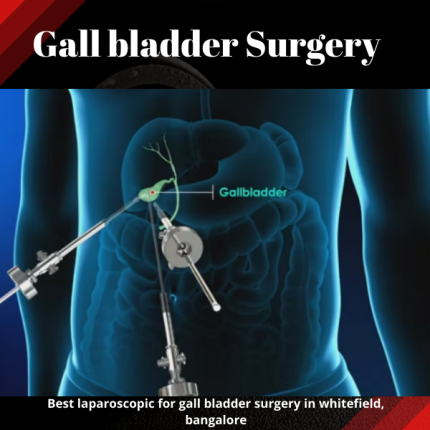Gallbladder Surgery
Dr. Nikhil Shellagi
MS Surgery, DNB Surgical Gastroenterology Fellowship in HPB and Liver Transplantation

Best Laparoscopic for Gall Bladder Surgery in Whitefield
Gallbladder Surgery
What Is A Gallbladder?
The gallbladder is a little pouch found next to the liver. Its job is to concentrate and store the bile juice that the liver produces.The liver produces bile, a substance that aids in the digestive process.
What Is A Gallbladder?
A cholecystectomy, often known as gall bladder surgery, is a surgical technique used to remove the gallbladder.
It is typically carried out when painful and uncomfortable hard pigments called gallstones grow in the gallbladder.
The gall bladder is a little sac that resides beneath the liver on the right side of the belly.

It is about the size and shape of a pear. Its major function is to store and concentrate the bile that the liver produces.
After eating, the gallbladder releases bile to help with digestion. Common bile ducts (CBD) allow bile to pass into the small intestine.
Pieces of a solid substance called gallstones grow in the gallbladder. These stones occur because bile pigments and cholesterol can occasionally condense into solid particles.
Types of Gallstones
- Pigment Stones: Usually smaller and darker, pigment stones are composed of bilirubin.
- Cholesterol Stones: Commonly yellow-green, approximately 80% of gallstones are cholesterol stones.
What Are The Symptoms Of Gallbladder Cancer?
- Severe abdominal pain that may radiate to the back in the right upper abdomen.
- Vomiting or nauseousness
- Bloated abdomen (gas formation).
- Food intolerance to fats.
- Discomfort.
- Although many people are asymptomatic, they can develop symptoms and lead to consequences.
- Management must be done on time.
If you want to know about (GCS ) apart from Gallbladder, then you can go to the page about Gastrointestinal Cancer Surgeon and get information.
Who will need to have gallbladder removal?
A laparoscopic cholecystectomy provides relief for those with gallstones that are infected and causing pain.
Crystals called gallstones to occur in the gallbladder. They may obstruct the passage of bile from the gallbladder into the digestive tract.
This obstacle results in cholecystitis (inflammation of the gallbladder). Gallstones can disperse throughout the body and harm other organs.
What is the Process of Laparoscopic Gallbladder Removal?
Your laparoscopic gallbladder removal will be done while you are under general anaesthetic. You are therefore unconscious during the procedure.
Your incisions are stitched, stapled, taped, or glued shut by the surgeon after the procedure. The doctor does not need to remove these because they vanish as you heal.
Once you are unconscious, the doctor makes a small incision close to your belly button and inserts a port, a little surgical tool.
Your surgeon can use the port-created aperture to inject gas into the abdomen. This makes room for performing the surgery. They then push a tiny camera into the port.
On a screen in the operating room, a camera captures the procedure. The surgeon inserts extra ports to implant long, narrow instruments once they can see clearly.
Finally, your gallbladder is carefully removed through one of the incisions after being disconnected. Most surgeries require three to four incisions, but some require more.
What if laparoscopic gallbladder removal is not an option for me?
Occasionally, laparoscopic gallbladder removal is not an option. If you fall within this category, you might require open surgery.
Among the causes for undergoing or choosing open surgery are:
- There is a lot of damage to your gallbladders, such as scarring or inflammation.
- Your abdomen has scar tissue from a previous operation.
- You are obese, which is a really large amount of weight.
- Through the laparoscope, the surgeon cannot see very well inside your body.
FAQ:
An hour or two passes during laparoscopic cholecystectomy. Some people should not undergo laparoscopic cholecystectomy.
In some circumstances, your surgeon may start with a laparoscopic approach and conclude that a wider incision is required due to difficulties or scar tissue from prior surgeries.
This procedure typically only causes minor discomfort. The minor incision sites and the belly will both be painful, and some patients will experience shoulder aches for the first couple of days.
Gas that was left in your abdomen after the operation is what’s causing your shoulder pain. It will vanish by itself.
- When you are exhausted, take a nap.
- Try to take a daily walk.
- Avoid lifting anything that would put you under strain for two to four weeks.
- Till your doctor gives the all-clear, stay away from vigorous activities like biking, jogging, weightlifting, and aerobic activity.
In general, the first 24 hours should be the only time you require complete relaxation.

